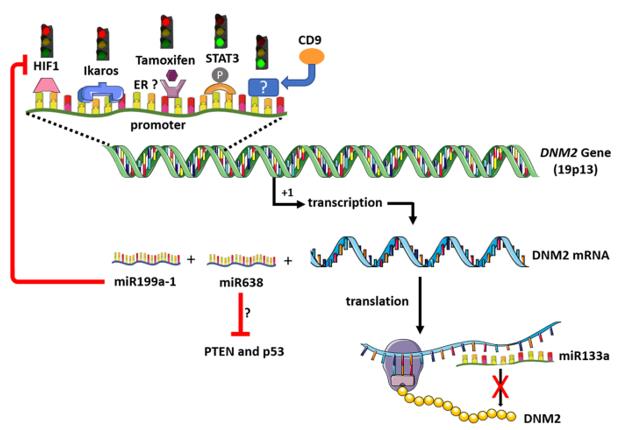What is DNM2 Protein
Officially known as Dynamin-2, DNM2 is a GTPase protein that falls under the dynamin family. Dynamin proteins are essential for vesicle formation and membrane trafficking within cells. DNM2, also referred to as Dynamin II, Dynamin-2a, or Dynamin-2b, is encoded by the DNM2 gene. Structurally, DNM2 is characterized by its modular organization, comprising a GTPase domain, a middle domain, a pleckstrin homology (PH) domain, a GTPase effector domain (GED), and a C-terminal proline-rich domain. Recent research has further illuminated the structural nuances of DNM2, shedding light on its classification within the larger dynamin family.
DNM2 Biological Functions and Molecular Mechanisms
The biological functions of DNM2 are diverse and pivotal for cellular homeostasis. Primarily, DNM2 is involved in endocytosis, the process through which cells internalize substances from the extracellular environment. By facilitating the formation and scission of clathrin-coated vesicles, DNM2 plays a central role in the endocytic pathway. Additionally, DNM2 participates in membrane remodeling, cytokinesis, and organelle dynamics.
At the molecular level, DNM2 functions as a mechanochemical enzyme, utilizing the energy from GTP hydrolysis to drive membrane fission. The GTPase domain of DNM2 plays a key role in this process, regulating the conformational changes necessary for membrane scission. Recent advances in research have unveiled intricate details of the molecular mechanisms governing DNM2 function, providing a deeper understanding of its role in cellular processes.

Figure 1. Regulation of DNM2 expression. (Trochet D, et al., 2021)
DNM2 Related Signaling Pathway
The signaling pathways involving DNM2 are complex and tightly regulated. DNM2 is intricately connected to various cellular pathways, including those associated with endocytosis, cytoskeleton dynamics, and cell division. Notably, DNM2 interacts with proteins such as clathrin, amphiphysin, and endophilin, forming a network of molecular interactions crucial for its function in membrane fission.
Understanding the signal pathways involving DNM2 is paramount for deciphering its broader impact on cellular processes. Unraveling these pathways opens avenues for targeted therapeutic strategies that aim to modulate DNM2 function in specific contexts, such as disease conditions.
DNM2 Related Diseases
The dysregulation of DNM2 has been implicated in various diseases, highlighting its clinical significance. Mutations in the DNM2 gene have been linked to centronuclear myopathy (CNM), a rare congenital muscle disorder characterized by abnormal positioning of cell nuclei in muscle fibers. Moreover, DNM2 mutations have been associated with Charcot-Marie-Tooth disease (CMT), a hereditary neuropathy affecting the peripheral nerves.
Understanding the molecular basis of these diseases sheds light on the crucial role DNM2 plays in maintaining the integrity of muscle cells and peripheral nerves. Researchers are actively exploring targeted therapeutic interventions to address DNM2-related disorders, aiming to alleviate the impact of these debilitating conditions.
DNM2's Applications in Biomedicine
The unique properties and functions of DNM2 render it a promising candidate for various biomedical applications. In diagnostics development, the detection of DNM2 mutations serves as a crucial molecular marker for diseases like CNM and CMT. Genetic screening for DNM2 variants enables early diagnosis and personalized treatment strategies for affected individuals.
Moreover, the role of DNM2 in membrane dynamics and endocytosis makes it a potential target for vaccine development. Understanding how DNM2 participates in the cellular uptake of antigens could pave the way for innovative vaccine delivery strategies, enhancing the efficacy of immunization.
In the realm of therapeutics, ongoing research explores the modulation of DNM2 as a potential strategy for treating DNM2-related diseases. Small molecules targeting DNM2 function are under investigation, aiming to restore cellular processes compromised by DNM2 mutations.
Recommended Products
| Cat.No. | Product Name | Species | Source (Host) | Tag |
|---|---|---|---|---|
| DNM2-18H | Recombinant Human DNM2, MYC/DDK-tagged | Human | HEK293 | Myc/DDK |
| DNM2-12105H | Recombinant Human DNM2, GST-tagged | Human | E.coli | GST |
| DNM2-2786H | Recombinant Human DNM2 Protein, GST-tagged | Human | Wheat Germ | GST |
| DNM2-26990TH | Recombinant Human DNM2, His-tagged | Human | E.coli | His |
| DNM2-17H | Recombinant Human DNM2, MYC/DDK-tagged | Human | HEK293 | Myc/DDK |
| DNM2-11H | Recombinant Human DNM2 Protein | Human | E.coli | |
| DNM2-12H | Recombinant Human DNM2 Protein | Human | E.coli | |
| DNM2-4045HF | Recombinant Full Length Human DNM2 Protein, GST-tagged | Human | In Vitro Cell Free System | GST |
| DNM2-1976H | Recombinant Human DNM2 Protein (Leu533-Glu731), N-His tagged | Human | E.coli | N-His |
| DNM2-6495HFL | Recombinant Full Length Human DNM2, Flag-tagged | Human | Mamanlian cells | Flag |
Reference
- Trochet D, Bitoun M. A review of Dynamin 2 involvement in cancers highlights a promising therapeutic target. Journal of Experimental & Clinical Cancer Research. 2021, 40: 1-12.

